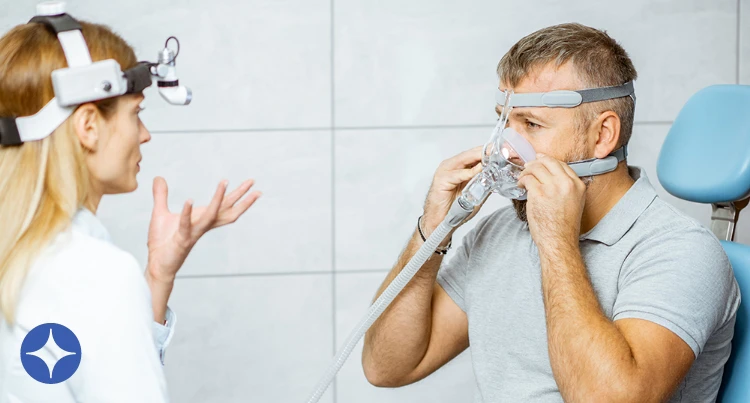
CPAP machines are an essential treatment device for people with obstructive sleep apnea, but many patients experience some difficulty adjusting to wearing the mask. Sleep therapy with continuous positive airway pressure (CPAP)1 helps improve breathing, so it's important to find ways to stay comfortable and stick to a routine of using the device every night.
Those newly diagnosed with sleep apnea who begin CPAP therapy may find it a frustrating process in the beginning, but this practical guide provides knowledge and support to help CPAP users adjust to using the device, overcome common challenges, and build a positive routine for better sleep.
Understanding CPAP Therapy
Sleep apnea2 is a condition where someone's breathing stops and starts during sleep. Symptoms of sleep apnea include daytime fatigue and loud snoring. The cause is most often an obstruction in the airway from relaxed throat muscles. Sleep apnea is a serious condition and requires a diagnosis and treatment.
CPAP machines3 are one of the most effective treatments for sleep apnea. They improve breathing and sleep quality by keeping the airways open to ensure a continuous flow of oxygen. CPAP therapy is highly effective. With consistent and proper use, up to 100% of CPAP users4 successfully treat their sleep apnea.
Getting Comfortable with Your CPAP Machine
Ensuring the mask fits properly5 is key for comfortable CPAP use. It may take some time to try out different mask types like nasal masks and full-face masks to discover which one works best. A sleep specialist can help guide this process.
Troubleshooting Common Issues
Nighttime issues with discomfort6 are a common complaint among CPAP users. Getting used to the mask can help. Users should wear the mask for short periods while awake to make the transition easier. Repeated exposure accompanied by relaxation techniques is a good solution to lessen feelings of claustrophobia. Checking the fit of the mask can help alleviate other complaints like dryness, irritation, and air leakage.
Some CPAP users find the noise of the CPAP machine distracting. New models tend to operate almost silently, but dirty filters and blockages can cause noise. If the filter is not the issue, then have the device checked out to make sure it's working properly. Those that still find the sound upsetting can try earplugs to block out any remaining noise.
Maintaining Your CPAP Equipment
Some CPAP components like the mask cushion, require daily cleaning7 to remove bacteria, dust, and other contaminants that could cause irritation or even illness. Gentle cleansing with mild soap and water is typically sufficient, but users should follow the manufacturer's instructions. Proper care not only prevents bacteria buildup but also prolongs the life of the machine and mask. CPAP users should also schedule regular equipment checks to ensure the device is working optimally.
Building a Routine for Success
A stable bedtime routine8 will help to encourage consistent use, even when symptoms seem to improve. Keep a regular bedtime that incorporates CPAP therapy until it becomes second nature.
Staying Motivated and Seeking Support
Getting used to a CPAP takes time and patience. Finding ways to make the experience more comfortable encourages continued use. CPAP users can get insights and advice from support groups and online forums like Apnea Board9 and CPAP Talk10. Other supports include Peer Mentors11 from Sleep Health, which provides one-on-one virtual support.
References
- National Heart, Lung, and Blood Institute – CPAP
- Mayo Clinic – Sleep apnea
- Cleveland Clinic – CPAP Machine
- Journal of Clinical Sleep Medicine – Long-term obstructive sleep apnea therapy: a 10-year follow-up of mandibular advancement device and continuous positive airway pressure
- CPAP Nation – Navigating CPAP Therapy: Tips and Tricks You Wish You Knew Sooner
- Mayo Clinic – CPAP machines: Tips for avoiding 10 common problems
- ResMed – How to Clean Your CPAP Equipment
- Penn State – Stable bedtime helps sleep apnea sufferers adhere to treatment
- Apnea Board – Sleep Apnea patients helping one another
- CPAP Talk – Sleep Apnea Forum
- American Sleep Apnea Association – Peer Mentors




